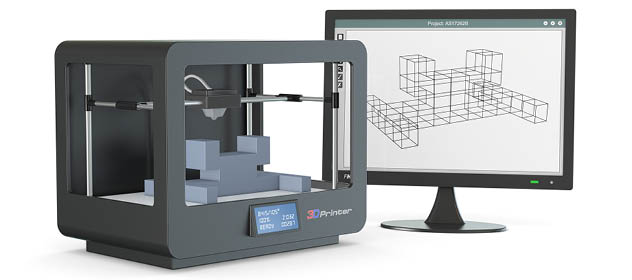
It’s in the news every week, school children are talking about it, most people in technology have probably heard about it, but what exactly is 3D printing?
Critics are saying it’s the next industrial revolution that’s due to change how the manufacturing industry operates. Industry leaders claim 67% of manufacturers in the UK are already using 3D printers in some capacity. With 3D printing set to expand exponentially over the next decade, thousands of jobs will need filling. Most importantly these should be for our current generation of children.
3D printing is also known as additive manufacturing and is a process of rapidly manufacturing products layer by layer. Imagine an inkjet printer that prints multiple layers on top of each other. Eventually you would build up enough layers to form a product. In education the most common form of 3D printing is called FDM (fused deposition modelling). This is where the printer heats plastic and extrudes it through a thin nozzle. The extruder moves around the ‘print bed’ printing the design rapidly resulting in a product that is manufactured. The advantages of this mean you can drastically reduce the time needed to manufacture a design.
Schools that have integrated 3D printing into the classroom are seeing amazing results. The technology is exciting to students and motivates them to succeed. Our tech savvy students want to be exposed to the latest technology and 3D printers lend themselves perfectly to this. It’s an extremely powerful tool to have at a teacher’s disposal and if delivered in the correct way can help inspire creativity. The process of 3D printing lends itself perfectly to the concept of iterative designing. Students will design, prototype, evaluate and re-design. This itself encourages higher level thinking and a more realistic experience to design and manufacture in the real world. My students have created all kinds of designs, from iPhone cases, cuff links/jewellery, bow ties and fashion accessories, to commercial lighting designs. The scope for designing and experimenting in 3D printing is vast. Students learn that it’s ok to make a mistake and this provides valuable learning opportunities in how to solve design problems. Also every year that my students have embraced 3D printing, GCSE results have increased and option numbers have sky rocketed.
To start 3D printing firstly you need a 3D printer and some materials. There are hundreds to choose from and the specs can be overwhelming, along with varying prices from £500 to £2000. For an unbiased review of printers the 2015 3Dhubs best printer review is a good place to start. Materials will usually be available from the printer manufacturer as well as hundreds of online stores that sell filament. Finally, to truly embrace 3D printing students will have to be taught how to design in 3D CAD. Packages such as Inventor, Creo and Solidworks are popular within education as they offer vast support networks for teachers to access. Once you take the 3D printing leap of faith you won’t regret it, your students will thank you.
- Find out more by reading 3D Hub's 3D Printer Guide
- By Philip Cotton
Philip Cotton has been teaching for seven years and has been nationally and internationally recognised for his work in 3D printing. He has led training sessions at the National STEM Learning Centre and has worked with the University of Manchester running 3D printing training sessions teaching PGCE students about 3D printing in the classroom.
He has been awarded the 3Dprintshow educational excellence award in 2013 and 2014 for his efforts in teaching students 3D printing and been featured in many publication such as Forbes.com, 3dprint.com, 3dprintingindustry.com and Makersempire.com. Philip will also be presenting at the CPD activitiy 'Using 3D printers creatively in KS3 and KS4 design and technology', which will be hosted at the National STEM Learning Centre.
To follow him on Twitter follow MrCotton @ladybridgeDT and to contact him directly visit his blog.
Related CPD activities:

